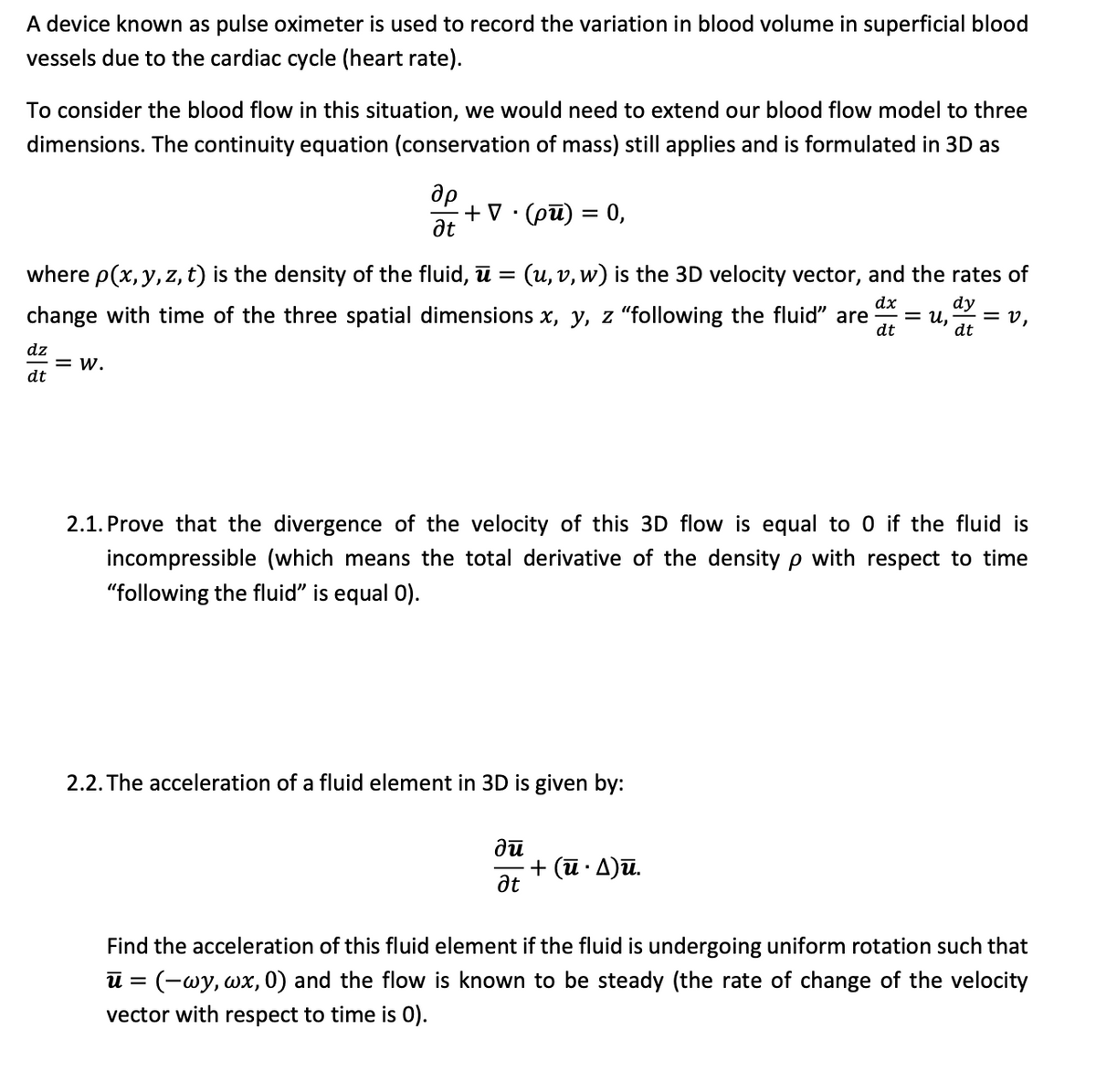A device known as pulse oximeter is used to record the variation in blood volume in superficial blood vessels due to the cardiac cycle (heart rate). To consider the blood flow in this situation, we would need to extend our blood flow model to three dimensions. The continuity equation (conservation of mass) still applies and is formulated in 3D as др + V • (pū) = 0, at %3D where p(x, y, z, t) is the density of the fluid, ū = (u, v,w) is the 3D velocity vector, and the rates of dx change with time of the three spatial dimensions x, y, z “following the fluid" are dt dy = U. dt = v, dz = w. dt 2.1. Prove that the divergence of the velocity of this 3D flow is equal to 0 if the fluid is incompressible (which means the total derivative of the density p with respect to time "following the fluid" is equal 0). 2.2. The acceleration of a fluid element in 3D is given by: ди + (ū · A)ū. at Find the acceleration of this fluid element if the fluid is undergoing uniform rotation such that u = (-wy, wx, 0) and the flow vector with respect to time is 0). known to be steady (the rate of change of the velocity
A device known as pulse oximeter is used to record the variation in blood volume in superficial blood vessels due to the cardiac cycle (heart rate). To consider the blood flow in this situation, we would need to extend our blood flow model to three dimensions. The continuity equation (conservation of mass) still applies and is formulated in 3D as др + V • (pū) = 0, at %3D where p(x, y, z, t) is the density of the fluid, ū = (u, v,w) is the 3D velocity vector, and the rates of dx change with time of the three spatial dimensions x, y, z “following the fluid" are dt dy = U. dt = v, dz = w. dt 2.1. Prove that the divergence of the velocity of this 3D flow is equal to 0 if the fluid is incompressible (which means the total derivative of the density p with respect to time "following the fluid" is equal 0). 2.2. The acceleration of a fluid element in 3D is given by: ди + (ū · A)ū. at Find the acceleration of this fluid element if the fluid is undergoing uniform rotation such that u = (-wy, wx, 0) and the flow vector with respect to time is 0). known to be steady (the rate of change of the velocity
Elements Of Electromagnetics
7th Edition
ISBN:9780190698614
Author:Sadiku, Matthew N. O.
Publisher:Sadiku, Matthew N. O.
ChapterMA: Math Assessment
Section: Chapter Questions
Problem 1.1MA
Related questions
Question
Thank you.

Transcribed Image Text:A device known as pulse oximeter is used to record the variation in blood volume in superficial blood
vessels due to the cardiac cycle (heart rate).
To consider the blood flow in this situation, we would need to extend our blood flow model to three
dimensions. The continuity equation (conservation of mass) still applies and is formulated in 3D as
др
+ V • (pū) = 0,
at
where p(x, y, z, t) is the density of the fluid, ū =
(u, v, w) is the 3D velocity vector, and the rates of
dy
= u.
dt
dx
change with time of the three spatial dimensions x, y, z “following the fluid" are
dt
= v,
dz
= W.
dt
2.1. Prove that the divergence of the velocity of this 3D flow is equal to 0 if the fluid is
incompressible (which means the total derivative of the density p with respect to time
"following the fluid" is equal 0).
2.2. The acceleration of a fluid element in 3D is given by:
ди
+ (ū · A)ū.
at
Find the acceleration of this fluid element if the fluid is undergoing uniform rotation such that
u = (-wy, wx, 0) and the flow is known to be steady (the rate of change of the velocity
vector with respect to time is 0).
Expert Solution
This question has been solved!
Explore an expertly crafted, step-by-step solution for a thorough understanding of key concepts.
This is a popular solution!
Trending now
This is a popular solution!
Step by step
Solved in 3 steps with 3 images

Knowledge Booster
Learn more about
Need a deep-dive on the concept behind this application? Look no further. Learn more about this topic, mechanical-engineering and related others by exploring similar questions and additional content below.Recommended textbooks for you

Elements Of Electromagnetics
Mechanical Engineering
ISBN:
9780190698614
Author:
Sadiku, Matthew N. O.
Publisher:
Oxford University Press

Mechanics of Materials (10th Edition)
Mechanical Engineering
ISBN:
9780134319650
Author:
Russell C. Hibbeler
Publisher:
PEARSON

Thermodynamics: An Engineering Approach
Mechanical Engineering
ISBN:
9781259822674
Author:
Yunus A. Cengel Dr., Michael A. Boles
Publisher:
McGraw-Hill Education

Elements Of Electromagnetics
Mechanical Engineering
ISBN:
9780190698614
Author:
Sadiku, Matthew N. O.
Publisher:
Oxford University Press

Mechanics of Materials (10th Edition)
Mechanical Engineering
ISBN:
9780134319650
Author:
Russell C. Hibbeler
Publisher:
PEARSON

Thermodynamics: An Engineering Approach
Mechanical Engineering
ISBN:
9781259822674
Author:
Yunus A. Cengel Dr., Michael A. Boles
Publisher:
McGraw-Hill Education

Control Systems Engineering
Mechanical Engineering
ISBN:
9781118170519
Author:
Norman S. Nise
Publisher:
WILEY

Mechanics of Materials (MindTap Course List)
Mechanical Engineering
ISBN:
9781337093347
Author:
Barry J. Goodno, James M. Gere
Publisher:
Cengage Learning

Engineering Mechanics: Statics
Mechanical Engineering
ISBN:
9781118807330
Author:
James L. Meriam, L. G. Kraige, J. N. Bolton
Publisher:
WILEY